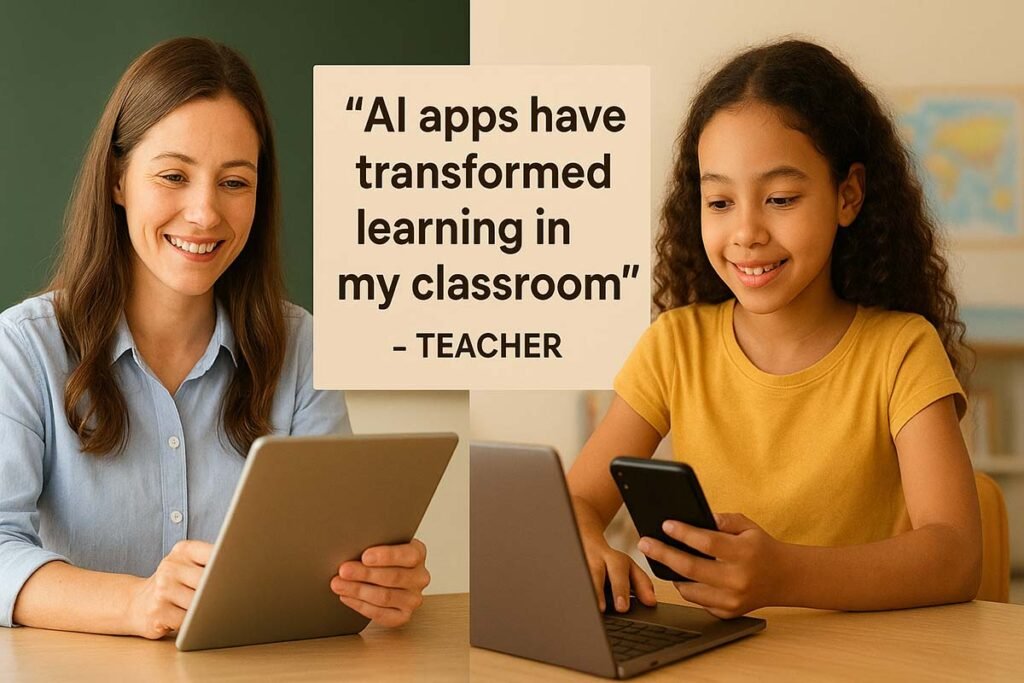The Future of Education in America: Imagine a classroom where lessons adapt instantly to your interests, AI-powered tutors offer help 24/7, and grades are delivered faster and with more nuance than ever before. In 2025, this is no longer a futuristic fantasy but a growing reality for students and educators across the United States. As artificial intelligence moves beyond science fiction, it is fundamentally reshaping how American learners of all ages experience education—both in-person and online.
But what does this really mean for students in Chicago, teachers in Houston, and parents in San Diego? Will AI bridge gaps or create new ones? And how can American education systems ensure these smart technologies empower, rather than replace, the human connections at the heart of learning? In this comprehensive, human-centered guide, we’ll unravel the facts, showcase real stories, break down trending tools, and offer actionable insights into the future of education in America.
AI in Education: The Future of Education in America
The wave of artificial intelligence in education has swept across the US with breathtaking speed. As of 2025, nearly 60% of American K-12 classrooms and 80% of post-secondary institutions incorporate some form of AI-driven technology—according to the National Center for Education Statistics.
Why is this happening?
- The 2020 pandemic forced massive digital adoption and exposed gaps in student support.
- US parents and teachers demand tech that saves time and individualizes learning.
- American employers value adaptable, tech-savvy graduates, fueling demand for innovation in schools.
Table: Key Drivers of AI in US Education
| Driver | Impact |
|---|---|
| Pandemic Remote Learning | Accelerated EdTech adoption |
| Growing Diversity in Student Needs | Need for personalization and inclusion |
| Teacher Workforce Shortages | AI-powered support for lessons and assessment |
| Regional Education Gaps | AI bridges urban, rural, and special-needs divides |
AI doesn’t replace educators. Instead, it augments their ability to reach every student efficiently and empathetically.
Adaptive Learning Platforms: Personalizing the Classroom
In the old model, all students learned the same way and at the same pace. AI shatters this one-size-fits-all system.
How Adaptive AI Platforms Work
- AI analyzes a student’s responses in real-time.
- The system adjusts questions, concepts, or presentation style—like a digital tutor reading a child’s mood.
- Top US Tools:
- DreamBox Learning (math, K-8)
- Khan Academy’s Mastery Pathways
- Carnegie Learning (high school math/ELA)
- Edmentum Exact Path
Real-life example: Jayden, a middle-schooler in Ohio, struggles with fractions. DreamBox’s AI slows down, gives more practice, and offers new explanations. When Jayden masters the skill, the program accelerates.
Benefits:
- Shrinks achievement gaps.
- Keeps advanced students challenged.
- Frees teachers to focus on creativity, discussion, and one-on-one support.
AI Tutors and Homework Bots: Extra Help for Every Student
Not every US family can afford after-school tutoring. AI levels the playing field—putting personalized help a click away.
Popular AI Tutoring Apps
- Socratic by Google: Snap a photo of homework for step-by-step explanations.
- Khanmigo (Khan Academy): Interactive chatbot tutor for math, science, and humanities.
- Photomath: Breaks down math problems with visual explanations.
- Duolingo (for languages): AI adapts lessons, reviews weak points, and practices pronunciation.
Bullet Points: Why Students Use AI Tutors
- 24/7 access—home, library, or school bus.
- No fear of embarrassment in front of peers.
- Immediate feedback and explanations.
Testimonial:
Maria, a high schooler in Texas, used Photomath to pass geometry. “It let me practice on my own time and gave tips I never got in class.”
Smart Assessment and Feedback: AI Grading and Analytics
US teachers face heavy workloads with large class sizes. AI reduces grading time and offers far richer assessment data.
How AI Assessment Tools Work
- Auto-grades multiple-choice, short answers, and even essays.
- Flag potential plagiarism or cheating.
- Surface learning gaps with data dashboards.
- Examples: Turnitin’s AI writing detection; Gradescope auto-scanning tests; US-based Edulastic for quizzes.
Table: Traditional Grading vs. AI Assessment
| Factor | Traditional | AI-enhanced |
|---|---|---|
| Speed | Hours/Days | Instantly or in minutes |
| Consistency | Subjective | Highly consistent |
| Insights | Manual review | Skill gap analytics, trends |
AI also supports special needs students with tailored assessments and accommodations.
Online Learning Gets Smarter: Virtual & Hybrid EdTech
After the pandemic, US virtual learning exploded—but many platforms lagged in engagement. Now, AI boosts quality and retention.
Key Features Making Online Learning Better
- Adaptive video modules based on attention tracking.
- Automatic note highlight and transcription (e.g., Otter.ai in US colleges).
- AI study companions—think AI chatbots answering questions on the fly.
- Group matching algorithms—connects students for peer learning or projects by interest and skill.
Case Study:
University of Michigan’s online 2025 AI course doubled graduation rates by using chatbots to answer common questions and AI “nudges” to remind students before deadlines.
Breaking Barriers: Inclusion & Equity with AI
America’s diversity demands tools that respect every background and ability.
How AI Fosters Equity:
- Language translation: Immigrant students get help through smart captions and translated resources.
- Accessibility tech: Voice-to-text and AI sign language interpreters support deaf and hard-of-hearing learners.
- Personalization: AI adapts for students with ADHD or dyslexia (e.g., text-to-speech, simplified interfaces).
- Data dashboards: Identifies and addresses achievement gaps quickly.
Example: In Los Angeles Unified School District, AI dashboards flag students struggling after family moves—enabling quick interventions.
Real-Life Examples & Case Studies
Example 1: Rural Access—Bridging the Digital Divide
A high school in Nebraska implemented adaptive math AI. Graduation rates increased by 15%, thanks to tools working even in low-bandwidth environments.
Example 2: NYC Urban Classroom
Jane, a 6th-grade science teacher, uses Edmentum’s Exact Path to personalize homework. Her class moved from below-average to district leaders in science scores.
Example 3: College Success Story
University of Florida used AI chatbots as 24/7 student support. Stress and dropout rates dropped; students reported feeling “more connected and less anxious.”
Quote:
“AI isn’t just changing how we teach—it’s giving us back the time to connect with our students!” – Mr. Sanders, Houston high school history teacher.

Pros & Cons: Opportunities and Challenges
Opportunities
- Personalized Learning: Less ‘average,’ more ‘individual.’
- Support for Teachers: More time for mentoring and project work.
- Broader Access: Rural, urban, disabled learners reach quality resources.
- Data-Informed Decisions: Schools act on real-time feedback.
Challenges
- Equity in Access: Not all US students have high-speed internet or devices.
- Bias in Algorithms: AI can reflect societal biases—constant oversight is needed.
- Privacy Risks: Student data must be fiercely protected.
- Overreliance: Tech should support, not replace, human interaction.
Table: Pros vs. Cons
| Pros | Cons |
|---|---|
| Adaptive learning | Risk of increased screen time |
| Teacher time savings | Digital divide / access gap |
| 24/7 homework help | Algorithmic bias |
| Accessibility and inclusivity | Student data privacy |
Expert Opinions: Teachers, Students, and AI Leaders Weigh In
“AI should be the engine, not the driver. It’s our job to make sure those tools serve human needs, not the other way around.”
— Dr. Elena Gomez, University of California, EdTech Specialist
“My AI tutor helped me catch up in math, but I liked that my teacher could see where I was struggling.”
— Aiden, 8th grader, Ohio
“We’re at the dawn of a new era—where American classrooms finally reflect our diversity and potential.”
— Sal Khan, Founder, Khan Academy
Actionable Tips: How to Get the Most from AI in Education
- For Students:
- Try free AI-powered apps for homework help or language learning.
- Review your school’s privacy settings when using EdTech platforms.
- For Teachers:
- Start with one AI feature (grading, adaptive lessons) before scaling up.
- Combine data insights with your professional judgment.
- For Parents:
- Ask which AI tools your district uses and how data is protected.
- Advocate for access to devices and internet in your community.
- For Schools:
- Pilot AI platforms in select classes, gather feedback, and adapt as needed.
- Train educators on both AI’s power and its limits.
Bullet Points: Avoiding the Pitfalls
- Balance AI use with human mentorship.
- Demand transparency from vendors.
- Prioritize ethical, inclusive tech adoption.
A New Era for American Learners
The Future of Education in America, powered by AI, is both inspiring and complex. These technologies can shrink learning gaps, free teachers to focus on connection, and prepare US students for tomorrow’s careers. But real progress depends on keeping people—not machines—at the center.
By making thoughtful choices, educators, parents, and policymakers can ensure AI lifts up every learner, from big cities to small towns. Ready to see what’s possible? Start exploring AI tools today and join the conversation for a smarter, kinder, more inclusive American classroom.
FAQ: AI’s Role in the Future of American Education
Q1: Will AI replace teachers in the US?
A1: No—AI supports and amplifies human teaching, but relationships and empathy remain irreplaceable.
Q2: Are AI EdTech tools safe for student data?
A2: Most major platforms comply with US laws (FERPA, COPPA), but always review privacy policies.
Q3: What’s the best AI learning app for US students?
A3: Apps like Khan Academy, Socratic, and Photomath are trusted and widely used in American schools.
Q4: Can AI close achievement gaps in diverse US classrooms?
A4: Yes, when paired with inclusive design and teacher oversight, AI can personalize support and improve outcomes.
Q5: How can American parents support safe AI adoption?
A5: Stay informed, talk to educators, and advocate for device access and data privacy protections.
Q6: Are AI assessment tools fair?
A6: They’re consistent but require regular audits to avoid reinforcing bias. Human oversight is crucial.
Q7: How do AI platforms help special-needs students?
A7: Text-to-speech, personalized pacing, and predictive alerts for early intervention can be transformative.




Pingback: Cybersecurity Essentials for Americans: Using AI to Protect Your Digital Life in 2025 - FirstsPost
Pingback: AI and Cybersecurity - How Artificial Intelligence is Revolutionizing Cyber Defense in 2025 - FirstsPost